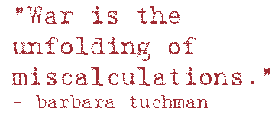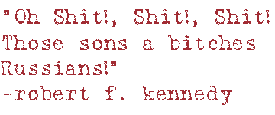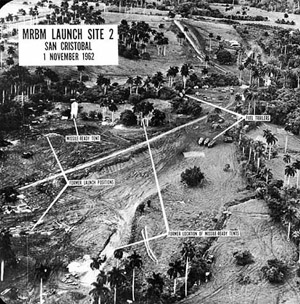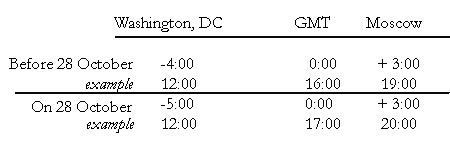Time
The problem was not missiles; the problem was time.
When grappling with a complex and multi-faceted problem, it is often best to distill the problem, or related problems, down to their root cause and establish the overarching problem. The United States military, for example, does this at three levels when planning an operation. They examine the strategic, operational, and the tactical problems. Once clearly and concisely identified, the efforts to develop solutions center around what is then called the problem statement.
the tactical problems. Once clearly and concisely identified, the efforts to develop solutions center around what is then called the problem statement.
During the Cuban Missile Crisis, the problem was time.
Looking with hindsight at the actions of American President John F. Kennedy and Soviet Chairman Nikita S. Khrushchev it is readily apparent that neither wanted war. Through hindsight, it is apparent that both were acting in defense of their nations’ interests and were positioning themselves in the world forum of international diplomacy. Only in hindsight can some sense be made of the tremendous risks taken by both countries.
Looking into the crisis, however, the risks and the tension become overwhelming. The American generals wanted war. The American Congress wanted war. The President and his Executive Committee of the National Security Council initially wanted war. Khrushchev wanted to support a new Communist ally. Castro ultimately showed his willingness to become a martyr. The United Nations demonstrated its feebleness to bring resolution to the conflict.
All of these pressures were exerted in the midst of inaccurate intelligence, terrible communication, and overestimation of martial ability. There was too much at stake to risk a failure using normal diplomacy. Normal solutions to international conflict took too long to develop and enact. With the prospect of nuclear war, normal was too risky. This paper seeks to address the problems in communication, the risks of miscommunication and misunderstanding all in light of the tremendous pressure of compressed time. This paper analyzes the key exchanges between President Kennedy and Chairman Khrushchev; acting Secretary-General U Thant and all belligerents; the President and his men; the Chairman and Prime Minster Castro; the commanders-in-chief and their generals; as well as the ambassadors, spies, and other secondary participants. The entire crisis was constrained by time – particularly the time it took to exchange information and conduct dialogue. In the twenty-first century’s Information Age it is incomprehensible that it could take twelve hours to send a ten page letter to its recipient half a world away. With the responsibility and risks related to nuclear warfare it seems criminal that a communications gap could trigger a nuclear event. In 1962, it was precisely a communications gap that nearly triggered a nuclear war.
Prelude
On Tuesday morning, 16 October 1962 the crisis’ tense thirteen days began for the leaders of the world’s two superpowers. Two days prior, two American U-2s flew over Cuba on a photoreconnaissance mission. The pictures produced by this mission provided the Central Intelligence Agency (CIA) concrete data that there were medium range ballistic missiles (MRBM) being placed in Cuba.1 McGeorge Bundy, Special Assistant to the President for National Security, was notified by Ray Cline, Deputy Director for Intelligence of the CIA, about 8:30 p.m.2 on the night of the 15th via telephone. The next morning,  President Kennedy was notified.3
President Kennedy was notified.3
On the 14th, the Marine Corps Emergency Actions Center (EAC) reported that all forces were at Defense Condition (DEFCON) 5 except Commander-in-Chief Pacific (at DEFCON 4 and subordinate elements in Asia at DEFCON 3), and Commander-in-Chief Strategic Air Command (SAC) (at DEFCON 4).4 By 17 October, no change DEFCON was reported and forces continued to build in support of a joint military exercise PHILBRIGLEX-62 planned for the Caribbean which would begin the following day.5
On Saturday, 13 October, Ambassador-at-Large Chester Bowles met with Soviet Ambassador Anatoly Dobrynin at the Soviet Embassy in Washington to discuss the trade embargo on Cuba along with other subjects. During that conversation, Bowles asked Dobrynin if he had read Barbara Tuchman’s Guns of August; when Dobrynin replied that he had not, Bowles “urged him to read at least the first few chapters in which he would see a pattern of politico-military action and counter action that could be repeated in the next six months.” He also suggested that the Soviets should be cognizant of the distinction between offensive and defensive weapons in Cuba, that they should not send any more arms, and that the Soviets should encourage Castro to state “that he has no design on his neighbors, that his entire energies would henceforth be devoted to the economic development of Cuba, and that he sought only peaceful competition with other Latin American nations.” Dobrynin listened and assured Bowles that no offensive weapons were being shipped and repeatedly asked “Why do [the Americans] get so excited about so small a nation?” 6
This highlights what would become the Soviet Union’s official stance with regard to weapons in Cuba. They intentionally side-stepped the issue regarding “offensive” or “defensive” weapons by claiming that they were simply supporting Cuba’s defensive capabilities. The Soviets did not deny weaponry and assistance sent to Cuba, while they expressed concern about the aggressive acts of and the threat represented by the United States. In this manner, they remained confident that they were being diplomatically forthcoming while continuing their rhetoric against the aggression of the United States.


